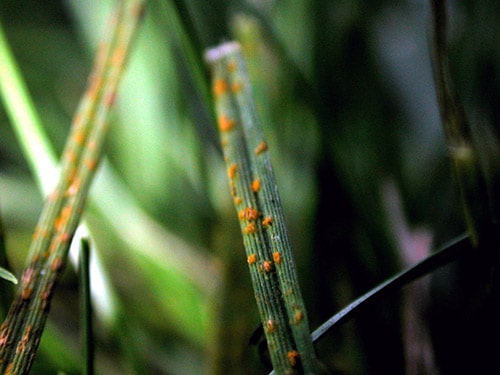Does your lawn look like a 1960’s astronaut had an accident with their powdered Tang packet? That is to say it looks as if it is coated with an orange or yellowish colored dust. Well it is probable that it is not an orange flavored drink mix, (nobody drinks that anymore!) but rather something called lawn rust. We know it seems unlikely that your lawn can rust, but this is not the type of rust you are use to. Let us break down what lawn rust is and how you can fix it.
Why Your Lawn is Rusty
Lawn rust is a type of fungus that affects turf grasses. That yellowish-orange powder that is visible is actually spores on the leaf blades. These spores can easily rub off on your hand if touched and can easily be tracked into your home.
Many types of plants are susceptible to rust fungus, from ornamental plants to evergreens. But on your lawn the fungus becomes very obvious due to the large amount of space the plant covers. Grass that is low in nitrogen (because of improper fertilization – link to blog) or has not been watered properly is usually at the highest risk for lawn rust. The weather can also have an effect. Cool nights and heavy rainfall are favorable for rust development. It is usually prevalent in late summer or early fall when lawn growth slows down.
Why it Matters
When the leaves of your grass are excessively covered with spores, the photosynthetic action cannot be accomplished efficiently. Which means good lawn health and growth take a hit. This is followed by poor stamina and a susceptibility to pests and other diseases. It’s a chain reaction that leads to a dead lawn.
What You Should Do
There are many turf grass species that are resistant to rust fungus. But we understand that replacing your sod is not always an option. So, we recommend other control measures. In fact, most grass rust problems can usually be resolved with good maintenance and healthy practices. Fertilizing your lawn is the best way to treat lawn fungus. Regular fertilizing of your lawn will encourage the grass to grow faster, as slow growing grass gives the disease lots of time to develop and entrench itself in your lawn. Mowing the lawn regularly cuts off the top layer of lawn rust fungus and allows the remaining grass to get proper air, which in turn reduces the amount of lawn rust that can grow. In some instances, fungicide may be used.
Good’s Tree & Lawn Care is committed to using the best quality products and personnel to provide a green and healthy lawn. Cultural practices are a large part of keeping your lawn green and healthy. These cultural practices include but are not limited to: proper mowing height and frequency, limiting excessive traffic during summer stress and freezing temperatures, proper irrigation and simply monitoring for any problems. Following proper practices can help protect your lawn from lawn rust and other diseases for seasons to come.


